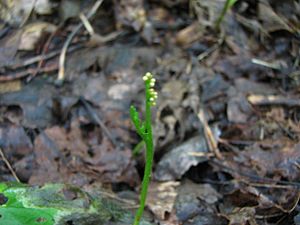Upswept moonwort facts for kids
Quick facts for kids Upswept moonwort |
|
|---|---|
 |
|
| Sporophore and trophophore of B. ascendens at its one station in Vermont. | |
| Scientific classification | |
| Genus: |
Botrychium
|
| Species: |
ascendens
|
The upswept moonwort (scientific name: Botrychium ascendens) is a special type of fern. It belongs to a plant family called Ophioglossaceae. People also call it the triangle-lobe moonwort.
This small fern grows naturally in North America. You can find it from British Columbia in Canada all the way down to northern California in the United States. It also lives in parts of eastern Canada.
Contents
Where the Upswept Moonwort Lives
The upswept moonwort likes to live in different kinds of places. It often grows in grassy areas, especially near rivers. These places provide the right amount of moisture and sunlight for it to thrive.
What Does the Upswept Moonwort Look Like?
This fern is quite small. It grows from an underground stem called a caudex. From this underground stem, it sends up just one yellow-green leaf.
The Leaf's Two Parts
The single leaf of the upswept moonwort can grow up to 6 centimeters (about 2.4 inches) tall. What's really cool is that this one leaf has two main parts:
- Sterile part: This part looks like a regular leaf. It has small sections that are shaped like a fan or a wedge. This part helps the plant make its food using sunlight.
- Fertile part: This part looks very different! It has tiny clusters that look a bit like grapes. These clusters are called sporangia. They are super important because they help the fern reproduce.
How the Upswept Moonwort Reproduces
Like all ferns, the upswept moonwort reproduces using spores, not seeds. The sporangia on the fertile part of the leaf are where these tiny spores are made. When the spores are ready, they are released into the air. If they land in a good spot, they can grow into a new upswept moonwort plant.

